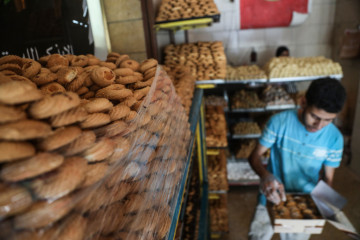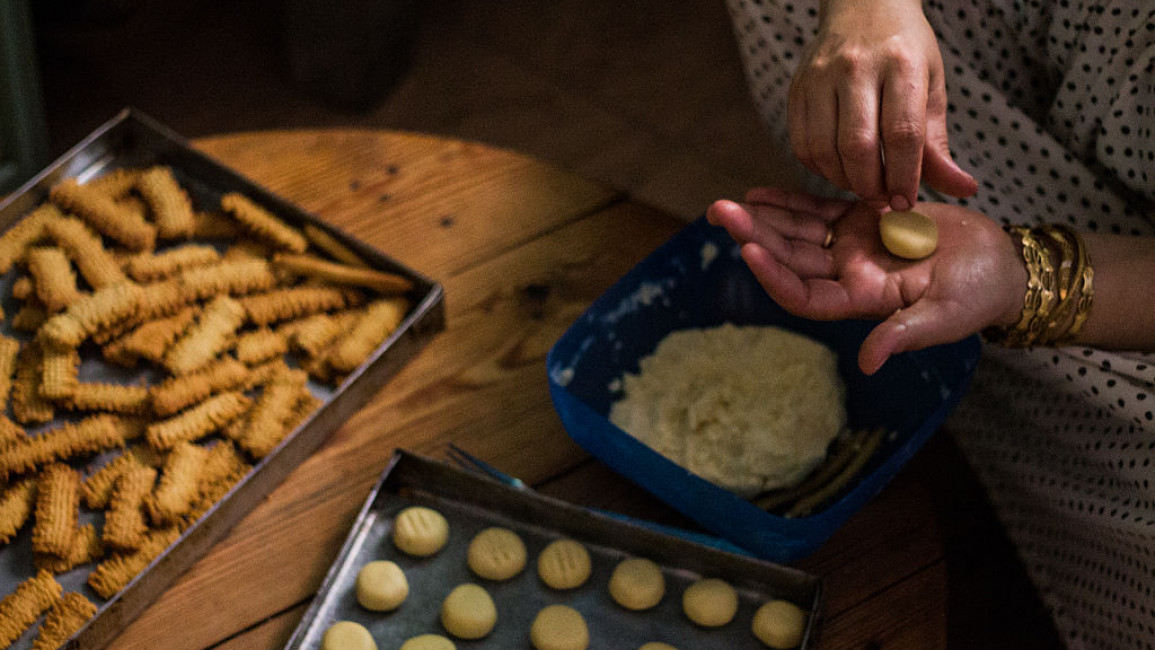

“Oh, kahk, the master of generosity, we will never stop baking you,” the late legendary Egyptian poet Fouad Hadad wrote in the 1960s in El-Kahk, a lyric performed and composed by renowned musician Sayed Mekawy who passed away years later.
The songwriter vividly and artistically described how the delicious, kahk (traditional Egyptian cookies) are made and look.
Whether a family is poor or rich, almost all Egyptian homes celebrate the first day of Eid al-Fitr with a breakfast of kahk and other delightful types of cookies with tea and milk – a heartwarming long-lived tradition.
It is not only Muslims who enjoy kahk for religious festivities, it is also found on the tables of Coptic Christians during Christmas on 7 January, a ritual believed to date back thousands of years ago.
How it originated
Historians believe the custom originated during the pharaonic times when wives of kings presented them as offerings to ancient priests.
“The shapes of cookies are found inscribed on tombs of the nobles in Thebes and Memphis such as that of Nakht-Rakhmki Ra,” pharaonic history expert Hussein Abdel-Bassier told The New Arab.
“Ancient Egyptians also served and ate circular-shaped cookies, which looked like those of today, filled with raisins or honey, during religious feasts, celebrations and other occasions… recipes are found in old transcripts,” he added.
Afterwards, throughout the rule of the different Islamic dynasties, kahk was one of the most impactful traditions that contributed to the Egyptian identity.
The Tulunid Dynasty created small, rolled packets called ‘kul wushkur‘(eat and say thank you). It became associated with Eid during the times of the Ikhshidid dynasty – a Turkic mamluk dynasty that ruled Egypt and the Levant from 935 to 969.
The Fatimids in specific adopted it in a bid to get closer to the Egyptian people, assigning special bakers to make it.
In 1124 A.D., the Fatimid caliphate Al-Aziz of Egypt allocated 20,000 dinars for baking kahk for Eid. According to other accounts, the feasting table was 1350 metres long, with many different varieties of kahk. Some historical accounts say that he even distributed it himself.
At that time, the very first bakery was established for only making kahk each Eid.
Old days vs the present
In modern history, throughout the last 10 days of Ramadan, it was common in most Egyptian households for mothers, grandmothers and children to gather to bake kahk and other types of Eid cookies, with each assigned a task.
Some knead while others cut the dough into small pieces, stuffing them with malban, nuts, and sometimes dates, while other types were left plain and not stuffed.
The topping and the special mark of most types of the traditional kahk, except the ones filled with dates, is powder sugar.
Kahk seasoning is a distinct blend of spices added to the ingredients, which gives it its characteristic flavour, known as ‘reehet el-kahk (the kahk essence), sold at Egyptian grocery and species stores.
Kahk is usually decorated before being baked in different shapes on top of the round-shaped piece, while girls in the family take some of the dough and make doll shapes to be baked with the rest.
Recipes are mostly the same when it comes to the conventional kahk with minor touches passed from one generation to another.
However, over the years, the habit of buying ready-made kahk has prevailed, especially among the younger generations and working women who cannot dedicate a few days of their busy week to baking it.
“I can still smell the baking of my late mother and my grandmother in my nose till now, years after they passed away. I miss these lovely old days,” one 36-year-old woman recalled, with a nostalgic sigh.
“Now I’m a mother of a baby and a three-year-old and I’m a working woman. There is no time to dedicate to kahk and no external help for such a tough job. It is as if the women of the old days had all the energy in them,” she told The New Arab.
An important member in the family of kahk is the delicious, popular ghorayeba, a round-shaped yellowish cookie that is either served plain or with nuts on top. On the other hand, eestern types of cookies have been added to the list of kahk El-Ei’d such as biscuits, petit fours and chocolate chips.
In recent months, due to the economic crisis, the country has been surviving and the price hikes of basic commodes, including flour, the basic ingredient, the cost of a box of the feast’s cookies has soared dramatically for an average Egyptian family to afford.
The prices of kahk and other types of cookies depend on the quality of the ingredients and the reputation of the pastry shop or the bakery house with a kilo that ranges from 60 to 400 Egyptian pounds.






 Follow the Middle East's top stories in English at The New Arab on Google News
Follow the Middle East's top stories in English at The New Arab on Google News


